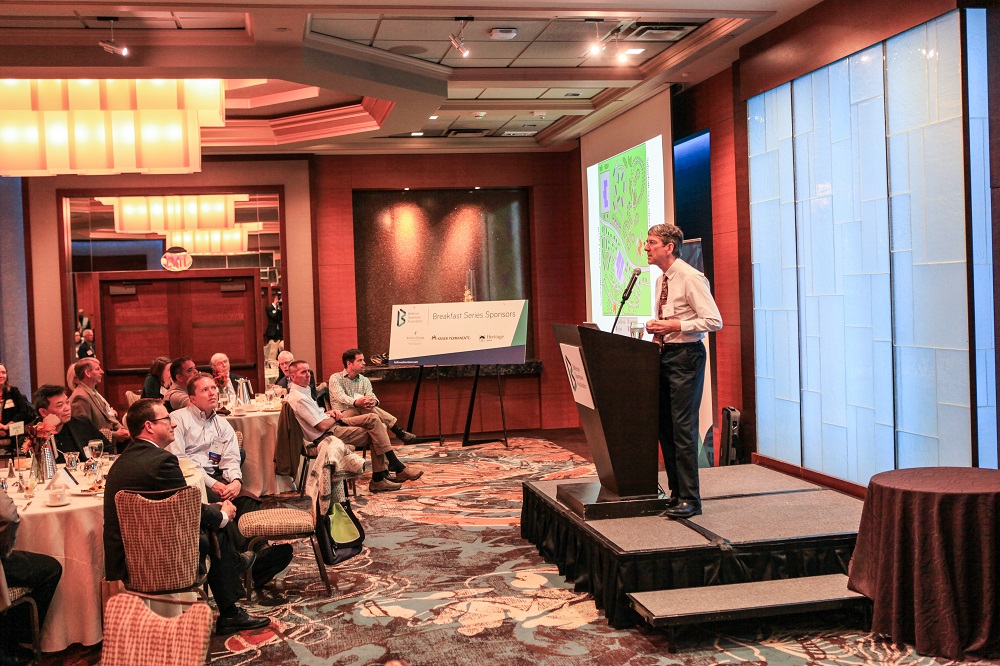September BDA Breakfast Recap: A Look Ahead at Bellevue’s Mobility Future
September 25, 2018 - by Paige Anderson, BDA Staff
Category What's Happening
A Look Ahead at Bellevue’s Mobility Future
Mark Hallenbeck was this morning’s speaker at the BDA’s September Breakfast series speaking on the topic “What data is telling us about mobility”. Mark gave a candid look at transportation challenges and opportunities in our downtown community and the suburbs surrounding our dense urban core (and giving a basic overview in land use and mobility habits along the way.) Read on for a recap of his presentation.

We started out with some hard numbers provided by the census which, unsurprisingly, show that driving alone is far and away the most common and preferred mobility method in Bellevue. Mark goes on to explain that although this is certainly true for our area, when reading statistics such as these we should consider that in mobility especially, it’s not always easy to capture one’s transportation habits in a single data point. Maybe you only drive on days when your daughter has soccer practice, or maybe you bike to the park-and-ride and then walk to work from the bus, but which single mode does the census capture? Bottom line is the data we have access to is imperfect, so we should always look for more ways to tell the mobility story.
Land Use & Mobility
 Here is Mark’s “famous green slide” where the top neighborhood shows us the design of suburban neighborhoods, which while providing an idyllic childhood, are also forcing us into car ownership. When we live in this type of neighborhood, we’re creating road networks that isolate us, making it inconvenient and potentially unsafe to get around without using a car. Land uses here are segregated; meaning if you want to go to a restaurant, you take the car. Same for getting to school, the grocery store, etc.
Here is Mark’s “famous green slide” where the top neighborhood shows us the design of suburban neighborhoods, which while providing an idyllic childhood, are also forcing us into car ownership. When we live in this type of neighborhood, we’re creating road networks that isolate us, making it inconvenient and potentially unsafe to get around without using a car. Land uses here are segregated; meaning if you want to go to a restaurant, you take the car. Same for getting to school, the grocery store, etc.
When you move to a dense urban environment with more connections through a grid network (such as in the bottom half of the neighborhood slide) you can walk to work, stop in that bakery on the way, and skip the traffic altogether. The places we need to go are that much closer together and easier to get to without a car (as is the case in Downtown Bellevue).
But, what if you can’t afford the urban core? We have to live where our opportunities are, and for many of us, the space and affordability of the suburbs mean that’s where we’re living, so, what can be done?
We may say, ‘widen the roads!’ or ‘bring in more buses!’ to solve the congestion problem, but Mark would challenge us to think more multi-modally about our travel options.
So, what does that mean?
Mark highlights other parts of the world including the Netherlands, where trains, bikes and good ol’ sneakers are the norm, despite the climate and geography. What makes it easier for the Dutch is the infrastructure and density. He suggests designing for density where driving just doesn’t make sense, there is no more space or it’s just too costly. We can look at walk scores when we look for a family home, and be open-minded about new ways to get around.
Let’s start thinking about time in a different way. ‘Time’ was one of the more compelling points Mark made this morning, in that when we commute in the car, even though it’s a shorter time spent commuting, that time isn’t productive time. You could drive for 30 minutes for your commute or take transit for 45 and make that 45 minutes a productive 45 minutes – since we can do practically anything from our smart phones these days (teleworking can be a great option, too!) It’s not just about what our tax money can build or what technology can bring. It’s about making incremental changes in our own patterns.
This is certainly food for thought as our BDA Transportation Committee is hard at work this fall on updating the BDA’s Downtown Access Strategy. This is a complex topic with a myriad of solutions at our fingertips. It will be important for our committee to get this right. What kind of mobility do you want to see in Downtown Bellevue? BDA members are weighing in through our committee process. Jump over to our advocacy pages to read more about how to get involved in the conversation.





